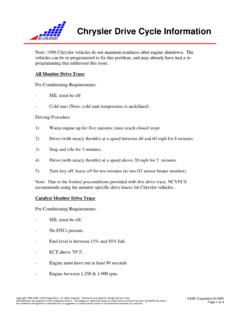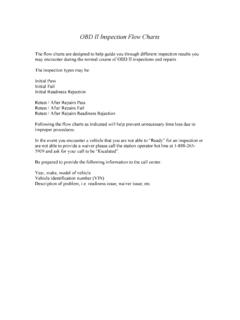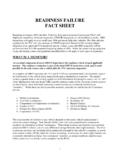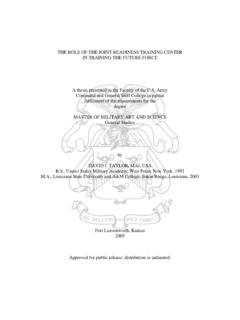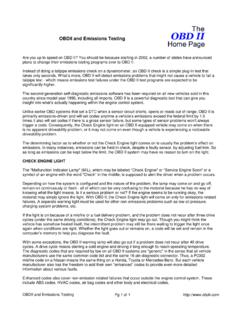Transcription of Emissions Readiness - UltraGauge
1 _____ Page 55/61 UltraGauge EM User Manual Emissions Readiness The Vehicle s Engine Control Module (ECM) performs two types of tests on the vehicle s emission system. The first type is a continual test or real-time test in which the ECM continually monitors the state of various system sensors to determine if the system is operating normally or if the system is outside of design specifications. For example, during normal operation should the coolant temperature suddenly output the lowest or highest possible value, the system assumes a temperature sensor fault has occurred. Typically the ECM then lights the Check Engine Light and posts a trouble code. The second type of test is a non-continuous test and often referred to as a monitor . This type of test is a long term test carried out during a driving cycle . Where the driving cycle might constitute the following: Example driving cycle A cold start A certain amount of idle time A certain level of acceleration (say 50%) Maintain a highway speed for a given time (55 MPH for 3 minutes) Deceleration for a given time A higher level of acceleration (say 80%) Again hold a steady speed Decelerate The above is just an example, and each manufacturer will likely have a different driving cycle.
2 Normally, the ECM will check off each of the driving cycle stages as they happen and they may or may not be in a particular order. Ultimately it s best to search the web to determine if the driving cycle for your vehicle is known. During the driving cycle several Readiness tests may be performed. The tests performed are manufacturer dependent. Readiness Test/Monitor Description (Gasoline Engines) Catalyst Monitors the condition of the Catalytic Converters. Condition is determined by monitoring the O2 sensors before and after the catalytic converters Heated Catalyst Catalytic converters work best when hot. To quicken the effectiveness of the converters, some vehicles electrically heat the catalytic converters. This test monitors the condition of the electrical heaters. Evaporative System Monitors the Evaporative System which is present to collect fuel vapor and later feed such vapors into the engine. Secondary Air System Some vehicles have a secondary air system which injects additional air (oxygen) into the exhaust system in an attempt to further burn any unconsumed fuel.
3 This monitor checks the condition of the various switches, solenoids, valves, etc. that make up the secondary air system Oxygen Sensor Monitors the operation of the vehicle s Oxygen sensors. O2 sensors measure the amount of Oxygen in the exhaust system and allow the ECM to properly set the air-fuel mixture. Oxygen Sensor heater Oxygen sensors do not function until they are hot. Most modern vehicles use an electrical heating element integrated into the O2 sensor to rapidly heat the sensor when the vehicle is cold. This monitor ensures the operation of the heating element in the O2 sensor. EGR and/or Variable Valve Timing The Exhaust Gas Recirculator system allows exhaust gases to re-enter the combustion chamber. Counter intuitively, this gas reduces the combustion chamber temperatures and reduces Nitric Oxide Emissions . This monitor ensures that the components of the system are operating correctly. The function of the EGR valve can also be accomplished with variable valve timing.
4 With this approach there is a very small window where both the intake and exhaust valves are open (if only slightly), and the exhaust can re- enter the cylinder during the intake stroke. Fuel System The ECM monitors the air fuel ratio by monitoring the O2 sensors to determine if the fuel system is operating properly. This is a continuous real-time test. The OBDII standard requires that the ECM always report the status as ready. As such there is no point reporting the Fuel System monitor status, and it is not supported by UltraGauge Misfire Engine cylinder misfires test. When the engine misfires, with all else being constant, there is a measurable decrease in RPMs. Combined with the CAM shaft position sensor, the offending cylinder can be identified. For gasoline engines, this is a continuous/real-time test and the Misfire monitor status always reads ready. Hence, the status is not displayed by UltraGauge .
5 Misfire Readiness is provided for Diesel engines. AC System The air conditioning system monitor was proposed when the alleged Ozone depleting R12 refrigerant was common. The Federally mandated replacement of R12 with R134a occurred in 1994. The OBDII was standardized two years later in 1996. Since R12 was replaced, the AC system monitor was no longer needed and was never made part of the OBDII standard. However, some manufacturers may have preemptively included the monitor into their ECMs in anticipation of the OBDII standard. In such an event, the monitor may be in place, but the vehicle will have R134a, hence the monitor is irrelevant. _____ Page 56/61 UltraGauge EM User Manual Readiness STATUS Status indicates if the test has completed or not. If not completed (Not Ready), it can mean a system component has prevented the test from completing.
6 For example, if the Speed sensor is not working, the test cannot complete since the drive cycle cannot be determined. However, it does not mean that the results of the test failed, only that the test completed or not. Once a test completes, and the test is marked Ready , the test may have passed or failed. If the test failed there will likely be trouble codes posted. Note that UltraGauge is simply the messenger, relaying information from the vehicle s ECM, and has no influence or impact upon the tests. The Test Status displayed by UltraGauge is one of four values: UltraGauge Status Display Status this current driving cycle (Left Column Status) Status since Trouble Codes last cleared (Right Column Status) The left column represents the Readiness status for the current driving cycle. Each time the engine is started, and in some cases when the ignition is switched off, the ECM attempts to rerun the various Readiness monitors/tests.
7 If a test completes, it will be reflected in the left column and the right column. If a monitor/test does not complete, NO will continue to be displayed in the Left Column, the right column will not be affected. The Right column represents the Readiness status since the trouble codes were last cleared. The right column is sticky, in that once a test completes and the status changes from NOT READY to READY, its sticks and will not revert back to NOT READY unless the trouble codes are again cleared, even if there are no trouble codes. To restart/clear monitor status, select: MENU Trouble Clear Check Engine This will clear any posted trouble codes and reset the Readiness status This status is not always available. It is more common on newer vehicles and less common on older 90 s and early 2000 s vehicles. If not supported by your vehicle, the column will show NR for all tests. (See NR above) If no results are shown, exit the menu, place the ignition to RUN and then rerun the Readiness menu item.
8 Always leave the ignition in the RUN position (engine off), prior to and while checking the Readiness status. This status is commonly available on all vehicles. If NR is shown, exit the menu, place the ignition to RUN and then rerun the Readiness menu item. Always leave the ignition in the RUN position (engine off), prior to and while checking the Readiness Status. The Status will continually be read and displayed until any key is pressed. If the ECM is running the monitors, the status may change in real time. The Refresh/Action symbols are displays on those tests which are being read and Description RDY Ready. The test has been completed NO Not Ready. The test has not completed N/A The vehicle does not support the test. NR No Response The vehicle did not respond because the ignition was not in the RUN position, or the vehicle does not support Current Drive Cycle Readiness .
9 Or the ignition was switch OFF, then back ON while viewing Readiness Status, and the vehicle is using 9141 or KWP2000 Protocol Catalyst RDY RDY Cat Heater N/A N/A Evaporative RDY RDY Secondary Air NO NO Air Condition N/A O2 RDY RDY O2 Heater RDY RDY EGR/VVT N/A N/A Refresh/action symbols _____ Page 57/61 UltraGauge EM User Manual Readiness Status Gas Engine MENU More .. Readiness Reports the Readiness status for various non-continuous/drive-cycle Readiness tests. The Readiness status will continually be read and displayed. As a result, if the ECM is busy running the monitors the status may change in real time. Pressing any key will halt the Readiness status monitoring and exit to the Menu. The following potential Readiness test status is presented by UltraGauge : Gasoline Engine Monitors Catalyst Monitoring Heated Catalyst Monitoring Evaporative System Secondary Air System Air Conditioning 02 Sensors O2 Sensors Heating EGR/VVT Please see the prior Readiness discussion for more details.
10 Note: Not all vehicles support and perform all of the tests above. Note: For those States that use Readiness as a means to determine Emissions compliance, the required tests and the number of tests is State dependent. Often a few failing monitors will not cause the emission inspection to fail. Check the State s website to determine which Readiness tests are critical. Note: To restart/clear Right Column monitor status, select: MENU Trouble Clear Check Engine This will clear any posted trouble codes and restart ECM Readiness monitors Diesel Engine MENU More .. Readiness Diesel The Readiness tests performed for a Diesel vehicle are different than those for gasoline vehicles. The Readiness status will continually be read and displayed. As a result, if the ECM is busy running the monitors the status may change in real time. Pressing any key will halt the Readiness reading and exit to the Menu. For Diesel Vehicles, the following potential Readiness test status is presented: Diesel MonitorsNMHC Catalyst Non-Methane Hydrocarbon Converting Catalyst.

